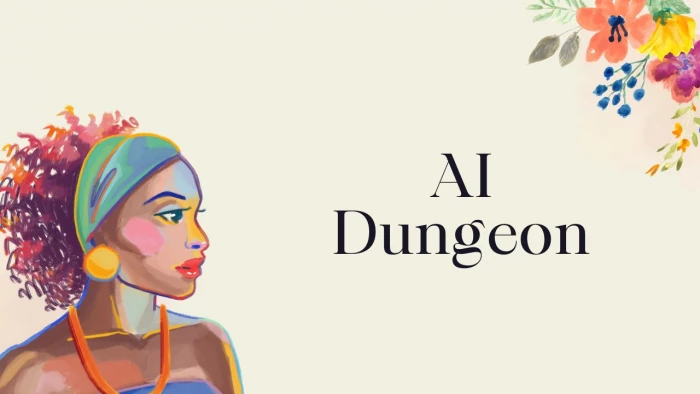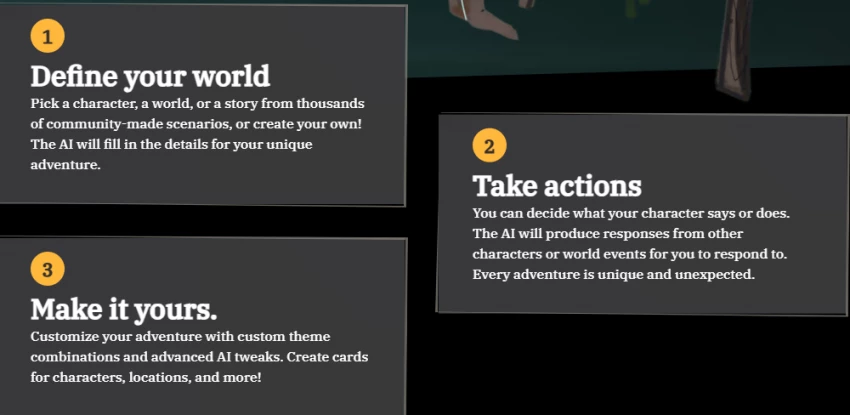

In 2019, developer Nick Walton launched AI Dungeon as a radical experiment: a text-based adventure driven not by scripts, but by neural networks. It leveraged OpenAI’s GPT-2 model to build worlds on the fly, letting players type any command and watch the AI respond with storylike logic.

That freedom quickly attracted millions. As detailed on Wikipedia’s AI Dungeon entry, the project later evolved into AI Dungeon 2 using GPT-3, giving narratives unprecedented realism.
And while this origin story explains how the tool began, the real fascination lies in why it exploded in popularity, and how players shaped its identity.
AI Dungeon didn’t succeed because it was perfect; it succeeded because it was unpredictable. The game delivers an infinite playground for imagination, a co-authored novel where you and the machine write each other’s lines.
Platforms like the AI Dungeon Saga hub now host thousands of user-made stories, showing how AI can empower community creativity. For many, it’s the first time a game felt like a conversation instead of a set of choices.
But creative chaos only works when structured, which brings us to the unique mechanics that make AI Dungeon both powerful and messy.
Each adventure starts with a short prompt; a single sentence can spawn a universe. The AI predicts what should happen next, weaving text that feels handwritten.
Unlike traditional RPGs, users create and share custom realms on the AI Dungeon Renaissance platform, shaping ongoing sagas that anyone can explore.
The mobile app on Google Play and iOS version sync perfectly with desktop play. Players jump between devices without losing progress, storytelling anywhere, anytime.

Understanding its mechanics helps, but the true intrigue lies in what powers it beneath the surface.
At its core, AI Dungeon uses transformer-based LLMs trained on millions of language samples. These models analyze your prompt, predict contextually relevant responses, and maintain a “memory” of prior actions to sustain narrative flow.
Think of it as improv theatre in code form: you start the scene, and the AI picks up your cues.
Developers describe this as procedural storytelling powered by dialogue.
With that foundation, let’s examine what actually makes the experience enjoyable for millions, and where it occasionally falters.
Many reviewers on Reddit’s r/AIDungeon call it “the best writing exercise disguised as a game.” Key strengths include:
Yet every strength has a shadow. The same freedom that makes AI Dungeon magical can also make it chaotic.
As detailed in 148Apps’ balanced review, the experience isn’t always consistent. Some sessions descend into surreal loops or nonsensical text. Others encounter overzealous content filters after past moderation controversies.
Premium tiers unlock better models like “Dragon,” but the freemium system sometimes frustrates casual players.
These issues triggered an important conversation, one that reshaped the platform’s policies and its community relations.
In 2021, privacy debates erupted when users learned that moderators could review certain flagged sessions for policy breaches. The ensuing uproar, documented on Wikipedia and discussed widely on Reddit, forced the team to clarify its practices.
AI Dungeon responded by overhauling moderation tools, publishing new help center policies, and promising greater transparency.
Ethical cleanup was necessary, but players still wanted technical reliability. Let’s see how the devs handled that next.
The AI Dungeon Renaissance initiative launched as a rebuild of both UX and backend architecture. It improved story generation speed, reduced lag, and introduced the “Memory” upgrade for longer narrative recall.
Community reactions on Discord and app stores suggest smoother AI coherence and fewer frozen prompts.
Many describe it as AI Dungeon growing up, but keeping its wild heart.
So far, this mix of creative freedom and technical progress has shaped a distinctive identity, one we can measure through user sentiment.

Across major review platforms, feedback paints a nuanced picture:
But how does AI Dungeon compare to other AI storytelling tools emerging in 2025? Let’s benchmark it.
| Platform | Unique Edge | Weak Spot | Best For |
| AI Dungeon | Unlimited creativity, strong community | Occasional incoherence | Writers, gamers |
| NovelAI | More structured story control | Subscription only | Fiction authors |
| ChatGPT Custom Mode | Coherent long plots | Lacks game interface | Educators |
| TextSynth Playground | Fast experimentation | No memory persistence | Developers |
While comparisons highlight its niche strength, the game’s appeal goes beyond competition, it’s about rethinking creativity itself.
Teachers and writers now experiment with AI Dungeon as a creative writing tutor, using its improvisational flow to teach narrative structure and character voice.
Gamified workshops have even appeared on 10Web’s AI tools directory, listing it as a case study in human–AI collaboration.
That educational impact shows where AI narrative design might head next, toward a new era of interactive authorship.
If the AI Dungeon Renaissance is any indication, the future of story games is less about prewritten scripts and more about adaptive imagination.
The developers hint at integrating retrieval-based memory, fine-tuned safety layers, and cross-game continuity, where your hero’s decisions persist across multiple worlds.
Which brings us to the final question, should you play it?
AI Dungeon remains one of the most daring examples of human–AI storytelling synergy. It’s unpredictable, chaotic, and sometimes flawed, but unmistakably alive.
If you’re a writer, role-player, or educator curious about the creative frontier, it’s worth diving in.
Just remember: the AI provides the ink, but you still hold the pen.
Be the first to post comment!